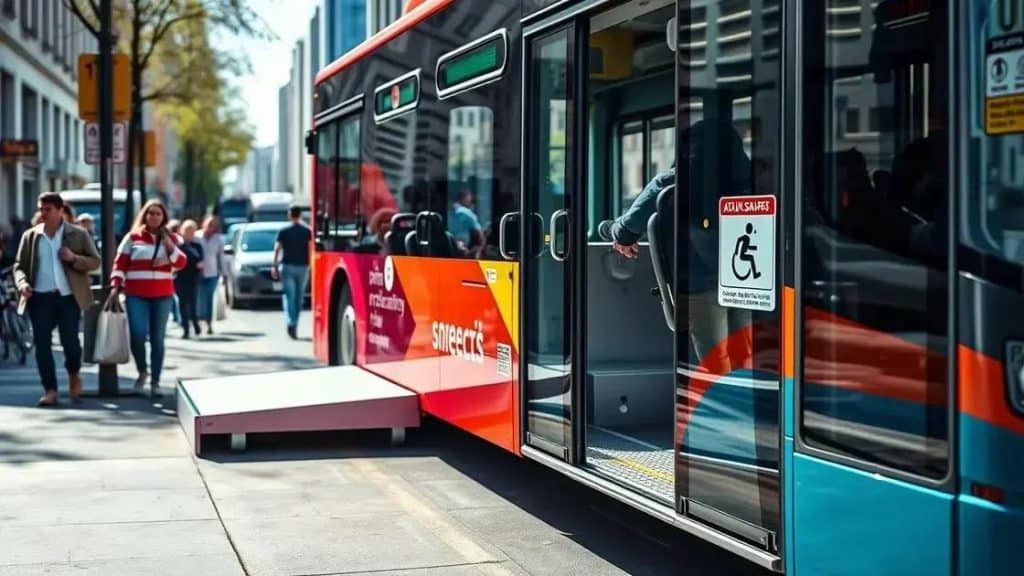Expanded access to public transportation for disabled citizens

Expanded access to public transportation for disabled citizens enhances independence, promotes social engagement, and drives economic growth, while challenges such as funding limitations and infrastructure issues need to be addressed for effective implementation.
Expanded access to public transportation for disabled citizens is not just a legal requirement, it’s a vital step towards inclusivity. Have you thought about how transportation impacts daily life for those with disabilities? This article dives into essential improvements and what they mean for real people.
The current state of public transportation accessibility
The current state of public transportation accessibility is a critical issue that affects many disabled citizens. Accessibility isn’t just about having ramps. It also involves ensuring that buses, trains, and stations accommodate all individuals. The goal is to create a system that is inclusive and easy to navigate.
Understanding Accessibility Features
Modern public transportation systems have adopted several features to enhance accessibility. These include:
- Low-floor buses that allow easy boarding.
- Audio and visual announcements to assist visually and hearing-impaired passengers.
- Accessible fare machines with large buttons and Braille.
- Priority seating for individuals with disabilities.
Despite these advancements, many areas still face significant challenges. For example, not all public transit systems have adequate training for staff regarding the needs of disabled passengers.
Challenges in Accessibility
Barriers remain in various regions, impacting the ability of disabled individuals to travel easily. In many cases, transportation routes do not connect essential locations, making it hard for disabled citizens to reach jobs, education, and healthcare. Additionally, maintenance of accessibility features can be inconsistent; broken elevators or escalators can limit access to key transit points.
Moreover, the lack of awareness among the public and policymakers can further hinder progress. Programs to educate and promote accessibility can often fall short, lacking the necessary attention and funding required for improvement.
An effective solution requires active collaboration among transit authorities, community organizations, and disabled advocates. Together, they can promote policies that ensure public transportation remains accessible to all.
Benefits of improved transportation for disabled citizens

The benefits of improved transportation for disabled citizens cannot be overstated. When public transportation systems enhance accessibility, it fosters a sense of independence and empowerment among individuals with disabilities. This means that they can travel freely without relying solely on others.
Increased Independence
Accessibility allows disabled citizens to navigate their communities with ease. This independence can lead to greater participation in social and economic activities. For instance, when public transport is accessible, individuals can:
- Attend work or educational institutions more regularly.
- Engage in leisure activities with friends and family.
- Access essential services like healthcare and shopping.
Freedom to travel can significantly improve mental health by reducing feelings of isolation.
Economic Advantages
When transportation is accessible, it opens up the job market for disabled individuals. They can reach various employment opportunities that were previously out of reach. This not only benefits the individuals but also the economy by:
- Increased workforce diversity, bringing new perspectives.
- Boosting productivity as more people contribute to the economy.
- Reducing dependency on social services.
Additionally, communities with accessible transportation see overall improvements in quality of life. Businesses can cater to a broader audience, which can lead to increased revenue. As public transport systems enhance their facilities, it builds a more inclusive environment for everyone.
Ultimately, the journey towards improved transportation for disabled citizens is about creating a society that recognizes the value of inclusivity. It is crucial to prioritize these changes to ensure equal opportunities for all.
Challenges faced in enhancing accessibility
There are many challenges faced in enhancing accessibility within public transportation systems. Despite progress, several obstacles can hinder the effective implementation of accessible services for disabled citizens. One significant barrier is the limited funding available for upgrading and maintaining accessibility features. Budget cuts can lead to inadequate resources for improvements, affecting transport quality.
Infrastructure Limitations
Many cities have infrastructures that were not originally designed with accessibility in mind. This can result in:
- Narrow sidewalks that cannot accommodate mobility devices.
- Inaccessible public spaces where transport connects.
- Old bus or train stations lacking necessary facilities.
Such limitations can make it difficult for disabled individuals to utilize public transport effectively.
Lack of Awareness and Training
Another challenge is the lack of awareness among staff and the general public about the needs of disabled passengers. Transportation staff may not receive adequate training on how to assist individuals with various disabilities. This can lead to frustration and decreased confidence for disabled individuals using public transport.
Furthermore, public awareness campaigns aimed at educating the community about accessibility issues often receive less attention than they should. Without widespread understanding, prejudice and misconceptions can persist, making it harder for disabled individuals to advocate for their rights.
It’s also essential that policymakers prioritize these challenges. Disregarding the need for thorough assessments can result in policies that do not consider the real-life experiences of disabled users of public transportation.
Overcoming these challenges requires collaboration among government, transit authorities, and advocacy groups. By working together, they can develop strategies that focus on integrating accessible transportation into everyday practices, ensuring that every citizen can travel without barriers.
Successful case studies of accessible public transport

There are inspiring examples of successful case studies of accessible public transport that highlight what is possible when communities prioritize inclusivity. Taking a closer look at these models can provide valuable insights and motivation for other cities seeking to enhance accessibility.
Case Study: London’s Transport System
London has made significant strides in improving public transportation for disabled citizens. The city’s Transport for London (TfL) has implemented a comprehensive accessibility program. With features like:
- More than 200 step-free access stations.
- Audio-visual information on buses and trains.
- Staff training programs focused on helping disabled passengers.
This commitment has allowed many people with disabilities to travel with confidence and ease.
Case Study: Seattle’s Accessible Transit
In Seattle, their Metro Transit system also serves as a positive example. They’ve adopted an approach that includes:
- Easy-to-read maps that include accessibility information.
- A dedicated outreach team that engages with disabled communities.
- Real-time updates on service changes for accessibility needs.
This proactive stance has allowed the city to significantly increase public transport usage among disabled citizens.
These examples illustrate how important it is for cities to be intentional in their planning. By investing in accessible transport, communities ensure that they cater to the diverse needs of all citizens. Additionally, success stories like these can inspire other regions to adopt similar measures, contributing to a larger movement towards accessibility and inclusivity in public transport.
In conclusion, enhancing access to public transportation for disabled citizens is essential for creating a more inclusive society. The success stories from cities like London and Seattle demonstrate that with the right investments and policies, we can make significant strides in accessibility. Challenges remain, but the collective effort of communities, government, and advocates can lead to meaningful change. By prioritizing accessibility, we empower disabled citizens to participate fully in daily life, benefiting everyone.
FAQ – Frequently Asked Questions about Accessible Public Transportation
Why is accessibility in public transportation important?
Accessibility is vital because it ensures that all citizens, including those with disabilities, can travel freely, participate in activities, and access essential services.
What are some examples of successful accessible transportation systems?
Cities like London and Seattle have implemented programs that include step-free access, audio-visual announcements, and staff training to help disabled riders.
What challenges do cities face in improving accessibility?
Challenges include limited funding, outdated infrastructure, and a lack of awareness or training for staff about the needs of disabled individuals.
How can citizens support accessibility initiatives?
Citizens can advocate for better accessibility through community engagement, participating in local discussions, and raising awareness about the importance of inclusive public transport.





